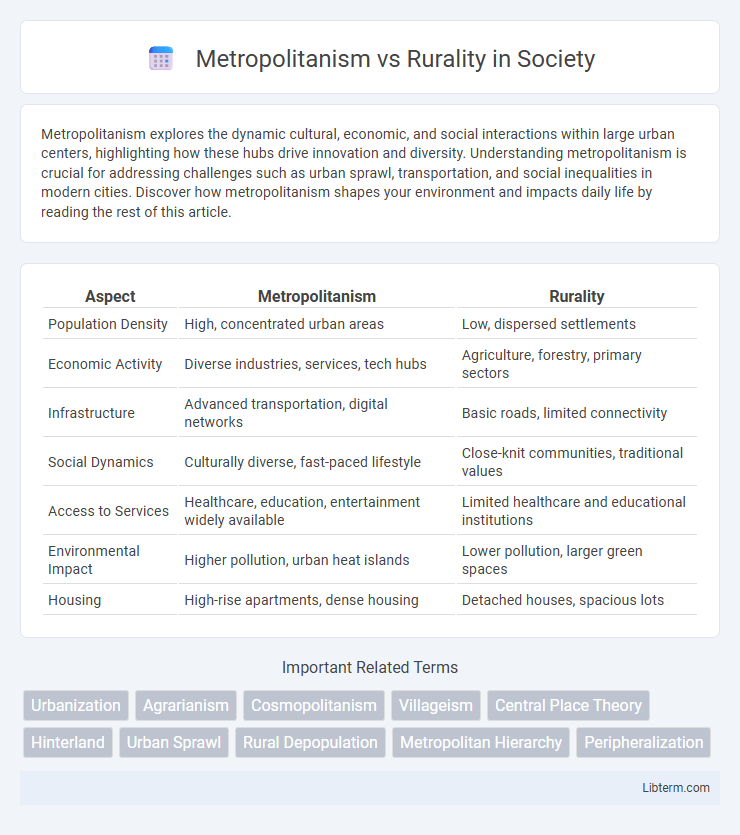Metropolitanism explores the dynamic cultural, economic, and social interactions within large urban centers, highlighting how these hubs drive innovation and diversity. Understanding metropolitanism is crucial for addressing challenges such as urban sprawl, transportation, and social inequalities in modern cities. Discover how metropolitanism shapes your environment and impacts daily life by reading the rest of this article.
Table of Comparison
| Aspect | Metropolitanism | Rurality |
|---|---|---|
| Population Density | High, concentrated urban areas | Low, dispersed settlements |
| Economic Activity | Diverse industries, services, tech hubs | Agriculture, forestry, primary sectors |
| Infrastructure | Advanced transportation, digital networks | Basic roads, limited connectivity |
| Social Dynamics | Culturally diverse, fast-paced lifestyle | Close-knit communities, traditional values |
| Access to Services | Healthcare, education, entertainment widely available | Limited healthcare and educational institutions |
| Environmental Impact | Higher pollution, urban heat islands | Lower pollution, larger green spaces |
| Housing | High-rise apartments, dense housing | Detached houses, spacious lots |
Defining Metropolitanism and Rurality
Metropolitanism refers to the lifestyle, culture, and economic activities characteristic of large urban centers with dense populations, advanced infrastructure, and diverse opportunities in industries, education, and services. Rurality denotes areas with low population density, limited infrastructure, and economies primarily based on agriculture, natural resources, and small-scale industries. Defining these concepts involves analyzing spatial distribution, social interactions, and resource allocation that differentiate metropolitan hubs from rural communities.
Historical Evolution of Urban and Rural Spaces
Metropolitanism and rurality have evolved through distinct historical trajectories shaped by industrialization, migration, and technological advancements. Urban centers expanded rapidly during the Industrial Revolution, fostering economic growth and cultural exchange, while rural areas maintained agricultural practices and local traditions. The interplay between metropolitan development and rural preservation continues to influence spatial organization, socioeconomic dynamics, and demographic patterns worldwide.
Socioeconomic Differences: Cities vs Countryside
Metropolitan areas typically exhibit higher income levels, diversified employment opportunities, and greater access to advanced education and healthcare compared to rural regions. Rural communities often face economic challenges such as lower wages, limited job markets predominantly in agriculture or resource extraction, and reduced public services. These socioeconomic disparities contribute to income inequality, migration trends, and varying quality of life between urban and rural populations.
Population Density and its Impacts
Population density in metropolitan areas often exceeds 10,000 people per square mile, leading to intensified infrastructure demands, housing shortages, and increased pollution levels. In contrast, rural regions typically have densities below 100 people per square mile, which results in limited public services and greater reliance on private transportation. These disparities influence economic opportunities, access to healthcare, and social dynamics, shaping distinct lifestyles between urban and rural populations.
Cultural Dynamics in Metropolitan and Rural Areas
Metropolitan areas foster dynamic cultural interactions driven by diverse populations, global connectivity, and rapid innovation, resulting in vibrant arts, multicultural events, and evolving social norms. Rural areas maintain strong ties to traditional practices, local heritage, and community rituals, promoting cultural continuity and close-knit social networks. The contrast between metropolitan cosmopolitanism and rural cultural stability highlights evolving identity expressions and socio-cultural resilience in different spatial contexts.
Access to Services: Urban Abundance vs Rural Limitations
Metropolitan areas boast extensive access to healthcare, education, and transportation services, enabling residents to benefit from specialized facilities and diverse opportunities. In contrast, rural regions often face limitations due to fewer hospitals, schools, and public transit options, resulting in challenges with service availability and quality. These disparities impact socioeconomic outcomes, highlighting the need for targeted policies to bridge the urban-rural service gap.
Environmental Concerns: Urbanization vs Rural Preservation
Rapid urbanization in metropolitan areas intensifies environmental concerns through increased pollution, habitat loss, and higher carbon emissions, challenging sustainable development goals. Rural preservation emphasizes maintaining natural landscapes and biodiversity, promoting ecosystem services and carbon sequestration as vital components of climate change mitigation. Balancing urban expansion with conservation efforts requires integrated planning approaches that minimize ecological footprints while supporting economic growth.
Migration Trends: Urban Drift and Rural Decline
Migration trends reveal a pronounced urban drift as metropolitan areas attract populations seeking better employment, education, and healthcare opportunities, resulting in significant rural decline. Statistical data from the United Nations indicates that over 55% of the global population now resides in urban areas, with projections reaching 68% by 2050, underscoring accelerating rural-to-urban migration. This demographic shift leads to economic stagnation and aging populations in rural regions, while metropolitan centers experience infrastructure strain and housing demand challenges.
Quality of Life: Perceptions in Metropolitan and Rural Settings
Quality of life perceptions vary significantly between metropolitan and rural settings, with urban residents often valuing access to diverse services, cultural amenities, and employment opportunities. In contrast, rural inhabitants prioritize environmental quality, community cohesion, and lower pollution levels. Studies reveal that while metropolitan areas offer convenience and social infrastructure, rural areas provide tranquility and a stronger sense of belonging, influencing individual well-being and satisfaction differently.
Bridging the Urban-Rural Divide: Strategies and Solutions
Bridging the urban-rural divide involves implementing integrated infrastructure development, enhancing digital connectivity, and promoting equitable access to education and healthcare services. Metropolitan areas benefit from concentrated economic opportunities and innovation hubs, while rural regions require targeted investments in transportation networks and technology adoption to boost local economies. Collaborative governance models and public-private partnerships play crucial roles in harmonizing resource distribution and fostering sustainable development across diverse geographic landscapes.
Metropolitanism Infographic

 libterm.com
libterm.com